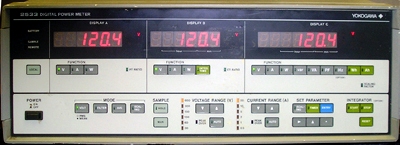
|
|
The Yokogawa 253321 Single phase (DC/AC) Digital Power Meter is a solution to accurate effective power measurement of distorted waveforms. This power meter is ideal for use on production lines and in research and development. A single digital power meter can measure effective values of AC voltage from 3 to 600 V (DC voltage can be superimposed), AC current from 100 mA to 30 A, and single-phase power from 300 mW to 18 kW. Voltage, current, and power measurements can be conducted by simply making a key selection. This meter features faster response time and a greater number of features than conventional models. A built-in photo coupler provides complete isolation between the power meter input and output circuits. With its high dielectric strength and high resistance to external noise, this meter offers stable and reliable operation. Specifications. Engineering Units: m, k, M, V, A, W, VA, var, Hz, h (hour). Function Selection: Manual for Display A, B, C each by front-panel keys (or remote via optional GPIB or RS-232-C interface). Sample Rate: Approx. 2.5 times/s. Ranging: Automatic or manual (or remote via optional GPIB or RS-232-C interface). Effective Measuring Range: 10 to 110% of rated value (range). Response Time: Approx. 0.4 S. (at filter OFF, for analog output within ±0.2% accuracy against an input variation from 30 to 100% of range, or from 100 to 30% of range). Display: LED display. Type of Input Voltage: Direct (DC CT isolation after ranging). Type of Input Current: DC CT isolation (secondary ranging). Rated Input (Range) Volt: 30, 60, 100, 150, 300, 600 V. Rated Input (Range) Current: 1, 2, 5, 10, 20 A. Max. Allowable Input (for 1 s): 3.5 x range (peak) or 1,400 Vpk (whichever is less), 10 x range (peak) or 70 A pk (whichever is less). Max. Allowable Input (continuous, at 50 or 60 Hz): 2 x range (rms) or 1,000 V pk (whichever is less), 3 x range (rms) or 50 Apk (whichever is less). Options. /GP-IB, GPIB Interface. /RS232C, RS-232-C Interface. /FRQ, Frequency Measurement, Range: 10 Hz to 200 kHz (filter OFF), 2 to 500 Hz (filter ON).
|